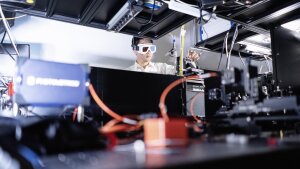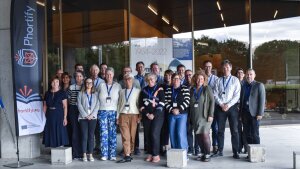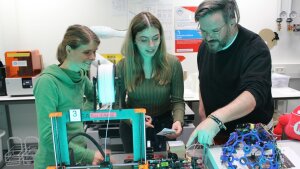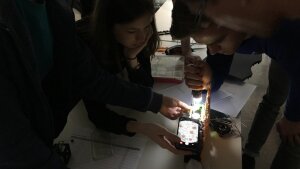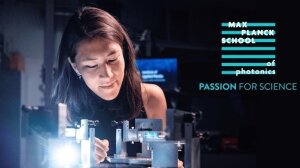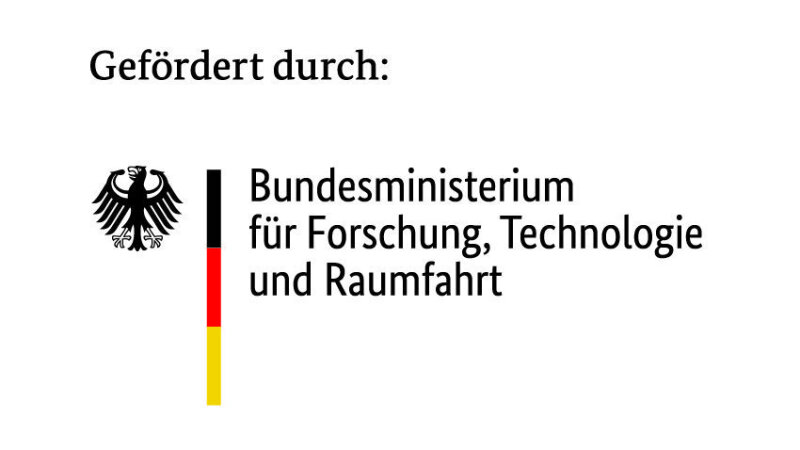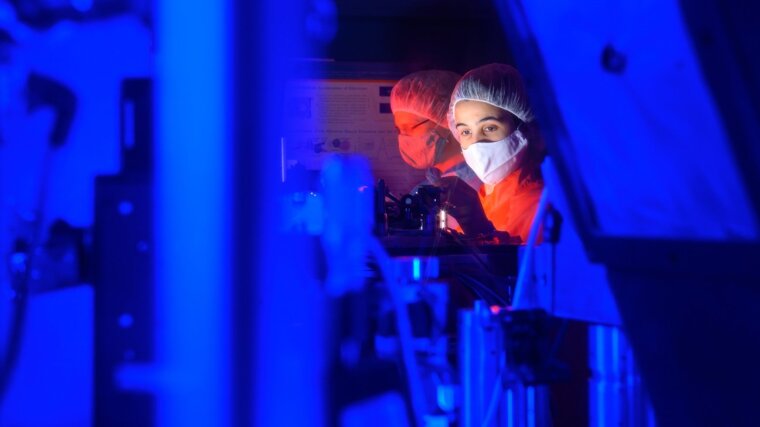
Strategic ACP funding focuses on large scale, interdisciplinary and sustainable collaborative research projects, some of whom are centrally anchored in the ACP research management:
Moreover, the following list is a selection of strategic research projects which have been acquired by ACP's principal scientists through competitive funding programs:
Running projects funded by the German Research Foundation (DFG)
-
EXC 2051 "Balance of the Microverse"
1st funding period 2019-2024, 2nd funding period 2025-2031
Microorganisms rule the world through space and time. Microbial consortia and their interactions control the environment and health. Their disturbance by (a)biotic factors has drastic consequences. A balanced interaction between all partners is critical for the maintenance of:
- Functioning of all ecosystems
- Stable climate
- Growth and well-being of plants and animals
- Human health and sustainable natural resources
The mission of the Microverse Cluster is to provide the scientific basis for understanding microbial balance from the molecular to the ecosystem level. We ultimately aim to develop technology allowing for targeted interventions to maintain or restore microbial balance.
-
SFB/CRC 1375 "NOA - Nonlinear Optics down to Atomic scales"
1st funding period 2019-2023, 2nd funding period 2023-2027
Most interaction between light and matter relevant to our daily life scales linearly with the incident intensity. However, nonlinear optical processes already begin to occur for light at moderate intensities, becoming more pronounced at higher field strengths. As a consequence, properties of light are modified, manifesting themselves in amplitude, phase, polarization or frequency changes. General examples of nonlinear optical processes are lasing and the generation of coherent light. Important specific examples are frequency conversion, supercontinuum and atto-second pulse generation.The investigation of these processes is the focus of our Collaborative Research Center (SFB/CRC) 1375 "Nonlinear Optics down to Atomic scales (NOA)" which started in July 2019.
NOA focuses on exploring fundamental nonlinear processes of light matter interaction in low-dimensional nanostructures, such as atomically thin layers, nanoparticles and -wires, nanostructured surfaces and molecular assemblies. We will explore quantum phenomena as light-induced tunneling of electrons through metallic nanogaps and field-driven carrier acceleration in plasmonic nanostructures, atomic lattices and 2D-materials. This includes the investigation of the resulting back-action on the electromagnetic field, causing the generation of higher harmonics carrying valuable information about the electronic wavefunctions involved in the interaction.
-
SFB/CRC 1278 "PolyTarget - Polymer-based nanoparticle libraries for targeted anti-inflammatory strategies"
1st funding period: 2017-2021, 2nd funding period 2021-2025
In the Collaborative Research Center PolyTarget, polymer-based nanoparticulate carrier materials for targeted application of pharmaceutical agents are being developed. The focus is on systems that are suitable for the therapy of diseases and syndromes characterized by an inflammatory reaction that significantly contributes to their morbidity.
-
TRR 234 Catalight - Light-driven Molecular Catalysts in Hierarchically Structured Materials
1st funding period 2018-2022, 2nd funding period: 2022-2026
CataLight is a transregional collaborative research center, funded by the German Research Foundation (DFG), hosted by the Friedrich Schiller University Jena and Ulm University. CataLight's project partners are at the Johannes Gutenberg University Mainz, Max Planck Institute for Polymer Research Mainz, the University of Vienna, the Leibniz Institute of Photonic Technology Jena (IPHT), the Technical University Kaiserslautern-Landau, the Argonne National Lab Chicago, and the Ohio State University. CataLight explores the controlled linkage of molecular light-driven catalytic units with hierarchically structured soft matter matrices to convert solar radiation into chemical reactivity.
-
IGRK/IRTG 2675 "META-ACTIVE - Tailored metasurfaces: generating, programming and detecting light"
1st funding period 2022-2027
Metasurfaces are two-dimensional arrangements of designed nanoscale building blocks that offer exquisite control over the properties of light fields and allow for the realization of ultra-compact, highly functional photonic devices. Within META-ACTIVE, the spatial light control provided by optical metasurfaces will be combined with the capability of their resonant building blocks to enhance light-matter interactions and/or facilitate a tunable optical response. Pertinent research questions encompass various projects in the areas of light-emitting metasurfaces, programmable metasurfaces and metasurface-enhanced detection.
In the framework of the International Research Training Group (IRTG) 2675 "META-ACTIVE", we will create and investigate active metasurfaces, which emit, detect and dynamically manipulate light, making use of the capability of their resonant meta-atoms to enhance the interaction of light with nanoscale matter. By combining the nanoantenna effect of the individual meta-atoms with the additional degrees of freedom offered by the arrangement, metasurfaces provide opportunities for tailoring light-matter interactions far exceeding the respective capabilities of individual nanoantennas. This scientific vision will lay the foundations for new types of high-performance (quantum) light sources, programmable optical systems, and enhanced detectors based on the metasurface concept.
-
GRK 3014 PhInt - Photo-polarizable Interfaces and Membranes
Learn more1st funding period 2024-2029
The Research Training Group "PhInt - Photopolarisable Interfaces and Membranes" at the University of Jena focuses on the underlying interactions between light and new materials. Prominent examples of light-driven processes and structures are photosynthesis, light-to-energy conversion in photovoltaics, but also light-driven molecular machines. In all these areas, it is necessary to understand the underlying interactions between light and materials in order to develop new materials with improved functionality. The PhInt research training group conducts intensive research into such interactions. The aim is to produce and characterise photoswitchable membranes and interfaces. The focus is on molecularly thin membranes and the interfaces of solids such as silicon and glass. One focus of PhInt is on characterising the molecular processes across material classes that lead to changes in the macroscopic properties of the materials. In addition, suitable methods are developed and established to study the processes that take place at the molecular level and sometimes extremely quickly. "
The German Research Foundation (DFG) is funding the GRK 3014 PhInt fund it from 1 September 2024. The research network, for which 5.8 million euros have been applied for over five years, will include 24 positions for doctoral candidates.
-
FOR/RU 2783 "Probing the Quantum Vacuum at the High-Intensity Frontier"
1st funding period 2018-2022, 2nd funding period 2023-2027
The quantum vacuum represents the ground state of Nature as it is described by quantum field theory, being the basic theory concept for all known matter and its particle-physics interactions.The interaction of light with the quantum vacuum gives rise to some of the most fundamental and exotic processes in modern physics, which remain largely untested in the laboratory to date. Tests of these iconic predictions of quantum electrodynamics (QED), the field theory of light and matter, are becoming possible just now. Seizing this opportunity is the goal of this DFG Research Unit FOR 2783. The advent of ultra-intense lasers with up to 10 petawatt (PW) peak power now provides a golden opportunity to advance our knowledge at the high-intensity frontier.Together with the current development of theoretical methods to describe fluctuation-induced quantum processes, the nonlinear regime of the QED vacuum is becoming accessible both experimentally and theoretically. The ambitious program of the Research Unit FOR 2783 in the 2nd funding period relies on firm theory predictions for quantum vacuum processes and aims at their experimental investigation combining the most advanced ultra-intense laser technology with novel high-purity detection schemes. FOR 2783 thus aims at a first experimental discovery of nonlinear quantum vacuum phenomena such as vacuum birefringence, general scattering phenomena of light such as quantum reflection and quantum-vacuum refraction, and lepton pair production in vacuum.
-
FIP 31/1 "TOOLS - Tailored Optics for Life Sciences Engineering"
Learn moreExternal linkFunding period 2024-2029
The TOOLS research initiative - Tailored Optics for Life Sciences Engineering - is an interdisciplinary collaboration of experts from the fields of optics and photonics, biomedical engineering, and clinical research. This project conducts fundamental research into optical technologies and biophotonic techniques to improve the understanding of biomedical processes in clinical settings. A core team, consisting of young and experienced scientists from the Ernst Abbe University of Jena (EAH Jena) and a partner from Jena University Hospital, is working together on the following specific research areas:
- Development of multifunctional monolithic optical components
- Design of customized multilayer diffractive elements
- Increasing the detection sensitivity of label-free bionanoparticles (bioNPs)
- Screening and non-invasive encapsulation of bioNPs
- Deep tissue endoscopy
- Multimodal biophotonic diagnostics of middle ear infections
With TOOLS, EAH Jena is building knowledge-based research expertise in the field of optical technologies and biophotonics. This closes the gap between basic and applied research. TOOLS enables fundamental new discoveries in optics and biophotonics and the targeted application of these findings in clinical research and medical diagnostics.
-
BioQantSense - Twinning for Excellence of the Serbian Research Center for Quantum Biophotonics (EU TWINNING 101079355)
Learn moreExternal linkFunding period 2022-2026
Biophotonics is a multidisciplinary scientific field with potentially high-impact applications in many sectors such as medicine, pharmacology, agriculture and environmental protection. Quantum biophotonics is an emergent field that allows making sensitive, reliable and traceable measurements in a bio-environment. The EU-funded BioQantSense project aims to raise the excellence and reputation of the Institute of Physics Belgrade (IPB) in Serbia especially in the field of quantum biophotonics. To that end, it will twin the IPB with two other renowned European research institutions. The project will help improve the management, administration and organisation skills of the IPB in international research and innovation activities.
-
EMIMEP - European Master for Industry in Microwave Electronics and Photonics (MSCA-EMJMD)
Funding period 2024-2029
ASP is a full member of the Erasmus Mundus Master (EMM) consortium EMIMEP. In the context of increasing demand for research and industrial applications, EMIMEP is a thoroughly integrated program with a jointly developed curriculum. Areas covered range from the fundamentals of microwave electronics and photonics to their implementations with new technology in wired and wireless communications, moving from components to system architectures for communication systems and networks. EMIMEP will offer full-scale scholarships for a 2-year Master's degree from at least two European Universities.
The EMIMEO consortium comprises the University of Limoges (France), the University of Brescia (Italy), the University of the Basque Country (Spain) and the University of Cluj-Napoca (Romania). For students, the program offers the opportunity of a Joint/Multiple Master's degree with these partners.
A website is currently built up.
-
METAFAST - Metasurfaces for Ultrafast Light Structuring (EU-FET-OPEN 899673)
Learn moreExternal linkFunding period 2020-2025
Photons have long since overtaken electrons as the medium of choice for data transmission over long distances. By manipulating their unique properties, speed, capacity, integrity and security can be improved to meet the demands of today's increasingly connected world. The most important parameters include intrinsic and orbital angular momentum. The EU-funded METAFAST project is developing a groundbreaking approach to ultrafast light patterning based on next-generation optical metamaterials. Success could increase the current speed of intrinsic and orbital angular momentum modulators sixfold, opening the door to a wealth of new applications for Industry 4.0 and the Internet of Things (check if translation is correct).
-
PHORTIFY - Photonics education network for next-gen innovation and digital skills excellence for industry and society
Learn moreFunding period 2025-2029
Phortify (Photonics education network for next-gen innovation and digital skills excellence for industry and society) is a Digital Europe Programme action delivered by a consortium of 12 partners coordinated by Vrije Universiteit Brussel (VUB). The initiative harmonises learning outcomes and quality assurance, enables cross-border mobility, and awards micro-credentials and certifications to accelerate Europe’s photonics talent pipeline.
Grant Agreement: No. 101226191 (Digital Europe Programme, lump-sum).
Running projects funded by the Federal Ministry of Research, Technology and Space (BMFTR)
-
3D-Vens - BMFTR research project on 3D measurement using explosion-proof endoscopy with structured illumination
Learn moreExternal linkdeFunding period 2024-2027
To address societal challenges such as climate neutrality, digitalization, and sustainability, extensive technological developments are necessary. A prominent example is the use of hydrogen as an energy carrier, the safe handling and societal acceptance of which require safe testing and maintenance. However, currently available inspection systems pose a high risk due to the use of electronic components, which themselves represent an ignition source, and therefore cannot be used in the vicinity of highly explosive substances such as hydrogen.
The consortium aims to develop a demonstrator that combines miniature optics, multi-core fibers, imaging fiber bundles, hybrid projection optics, and a novel endoscopic 3D measurement method. Compared to the state of the art, it will be more integrated and thus explosion-proof, as no electronic components are used in its measuring head.
The technology presented in 3D-Vens allows access to previously inaccessible, explosion-prone measurement volumes without electronics at the distal end. The innovative lighting concept differs from previous approaches, is more robust against endoscope cable deformation, and allows for a reduced size. This opens up new fields of application, such as pattern projection, 3D measurement, and translational endo-microscopy for industry and medicine. There is great potential for commercial use in terms of sustainability and climate neutrality.
-
BeRyQC - BMFTR joint research project on benchmarking Rydberg quantum computers
Learn moreExternal linkdeFunding period 2025-2028
Quantum computers based on neutral atoms trapped in optical traps have established themselves in recent years as a promising platform for both universal gate-based quantum computers and quantum annealers. Entanglement between the qubits is achieved by excitation into a so-called Rydberg state. These platforms are therefore called Rydberg quantum computers. They are characterized by several special properties: for example, it is possible to modify connectivity during algorithm execution using shift operations or to implement many-body gates.
This project aims to establish benchmarks for these Rydberg quantum computers that utilize the platform's special and characteristic properties to obtain reliable insights into their functionality. The focus is on the non-trivial operation of the quantum computer, which is crucial for generating a quantum advantage. For example, the degree and scaling of the achievable entanglement are meaningful metrics. Entanglement is a quantum mechanical property that cannot be realized in classical systems and is also difficult to simulate on a classical computer.
The goal is to establish these benchmarks as a standard for quantum computing platforms, thus providing a reliable measure of the functionality of the various Rydberg platforms. In particular, the benchmarks should also determine the hardware requirements for application-related problems that must be met to solve such problems efficiently and using quantum efficiency.
-
DriveEUV - BMFTR joint research project on highly efficient drivelasers for EUV lithography
Learn moreExternal linkdeFunding period 2025-2028
EUV lithography is considered a key technological innovation for semiconductor manufacturing. Currently, the EUV sources used are based on high-power CO2 laser systems. However, the semiconductor industry's roadmap requires a significant scaling of EUV power while simultaneously reducing complexity and costs.
The aim of this project is to develop the foundations for a new drive laser technology in order to maintain and expand Germany's strong, geopolitically relevant position in EUV lithography. To this end, various concepts for a solid-state laser-based 2 μm drive laser will be evaluated. Based on this technology comparison, prototype modules for coherent and spectral beam combinations will be developed and tested. This will allow the research of essential technologies for the new concept, the identification of technological limitations, and the demonstration of the approach's feasibility both theoretically and experimentally.
Current numerical and experimental studies show that a drive laser technology based on solid-state lasers at a wavelength of 2 μm can significantly increase the overall efficiency of EUV generation. The development of corresponding highly efficient, high-energy, and high-power solid-state lasers is therefore necessary to advance EUV lithography as a central element of the semiconductor industry worldwide. The DriveEUV consortium aims to establish the technological basis for an innovative drive laser concept for the next generation of EUV exposure systems within the project timeframe.
-
EXSAM - BMFTR joint research project on coherent extreme ultraviolet beam sources for analysis and measurement technology
Learn moreExternal linkdeFunding period 2023-2026
Extreme ultraviolet (EUV) radiation plays a key role in the analysis and control of materials at the smallest scales. The generation of highly brilliant EUV radiation can be achieved by producing high harmonics with femtosecond lasers. The excellent beam quality, the temporal structure of the emission, the debris-free operation, and the exceptionally high brilliance are crucial advantages. Potential applications include imaging and analysis at the micro- and nanoscale, as well as in the field of material modification. Despite the enormous potential, applications of these radiation sources have so far been limited to the scientific field. The collaborative project EXSAM aims to fundamentally change this situation, stimulate industrial applications, and lay the foundation for successful commercialization.
The project aims, on the one hand, to explore new concepts for the realization of improved EUV sources and associated optics. On the other hand, it aims to promote the targeted development of new applications and markets. The consortium pursues a holistic approach, pooling the expertise of various partners from the fields of laser technology and frequency conversion, optics, and instrumentation.
EXSAM focuses on researching and demonstrating three specific applications. At the same time, the project extends far beyond its objectives, opening up fundamentally new fields of application, potentially including the life sciences and medical technology.
-
GOI-4-IQ - BMFTR joint research project on nano galliumphosphide-on-insulator for integrated quantum photonics
Learn moreExternal linkdeFunding period 2024-2027
Gallium phosphide (GaP) exhibits significantly improved physical properties compared to established material systems for quantum nano-optics, including high transparency in the visible spectral range, a high refractive index, and high optical nonlinearity. Despite its outstanding properties, GaP remains a material rarely used in photonics and quantum optics. This is largely due to the limited availability of high-quality, single-crystal GaP thin films on low-refractive-index, transparent substrates (GaP-on-insulator, GOI).
This collaborative project aims to develop single-crystal GaP thin films on glass substrates as a novel platform for highly integrated quantum nano-optics. The produced GOI wafers will then be further micro- and nanostructured laterally, with a particular focus on realizing photonic integrated circuits and metasurfaces. The advantages over established material platforms will be demonstrated through several quantum optical demonstration experiments.
The planned realization of integrated quantum optical systems based on GOI presents a major technological challenge. Industry-led collaborative projects and corresponding substantial infrastructure investments by companies can only be expected once the benefits and superiority of the material system have been experimentally demonstrated in application-relevant structures. This collaborative project aims to achieve this. If successful, the project will contribute to strengthening the technological sovereignty of Germany and Europe in the field of highly integrated quantum technologies.
-
Hands-on! The MINT-Makerspace - BMFTR education and outreach project
Learn moreFunding period 2025-2028
In the project "Hands-on! The MINT Makerspace: Practical relevance, self-efficacy, opportunities and potentials for schoolgirls, female students and female doctoral students" (short: MINT Makerspace), we will target group-specific STEM participation formats. The main goal of the MINT Makerspace is to motivate and engage more females in the education and job opportunities in STEM. Particular attention is paid to the diversity of our target groups.
-
InfectoGnostics - BMFTR Federal Research Campus
Learn moreExternal linkFunding period 2013-2027
As a public-private partnership, the InfectoGnostics Research Campus Jena is breaking new ground in the diagnosis of infections. More than 30 partners from science, medicine and business are working together to develop novel solutions for the rapid and cost-effective on-site diagnosis of infectious diseases.
At the research campus, innovative photonic and molecular biological methods are developed and combined to reliably detect infectious agents (especially viruses, bacteria and fungi) as well as antibiotic resistance and to better understand the host response (e.g. in sepsis). The triad of technology, application and production creates laboratory and rapid tests for use in human and veterinary medicine as well as for food safety. This unique cooperation between public and private partners on equal terms breaks down barriers to the establishment of new diagnostics: promising solutions from basic research are brought into the diagnostic routine and thus to users and patients more quickly in the form of market-ready products.
-
Leibniz Center for Photonics in Infection Research, funded in the framework of the National Research Infrastructure Roadmap
Learn moreExternal linkRealization phase 2019-2023, Operational phase 2024-2032
Infectious diseases are among the most common causes of death worldwide, but antibiotic-resistant pathogens complicate treatment. As a consequence, there is an immense need for new therapeutic approaches and rapid diagnostic procedures. The light-based ones, together with artificial intelligence, support physicians in their diagnosis and give them a time advantage; artificial intelligence, in particular, helps with data evalutation and enables reliable diagnostics. Moreover, photonics can be considered to be a powerful tool in the research and development of new therapeutics and also machine learning methods are seen as able to interpret complex measurement data in order to derive diagnostic information.
-
LichtBriQ - BMFTR joint research project on lithium niobate thin-film substrates and structuring of building blocks for integrated quantum optics
Learn moreExternal linkdeFunding period 2024-2027
Integrated photonic circuits (PLCs) are becoming increasingly important due to the growing demands for miniaturization, stabilization, and scaling of optical assemblies, not only for classical applications but also for various areas of quantum technologies. However, conventional CMOS-based platforms such as Si, SiN, or lnP cannot meet all these requirements. Therefore, the development of new material platforms and the qualification of corresponding manufacturing processes for industrial and scalable use represent the greatest challenges.
The aim of this project is to develop an integrated quantum optical system based on thin-film lithium niobate (LNOI) as an industrial platform. This will involve advancing the fabrication, structuring, and processability of LNOI wafers, as well as the scaling of the platform. On the other hand, the unique properties of LNOI, such as electro-optical modulation in the GHz range and the generation of quantum states, will be used to realize reproducible, scalable, and flexible photonic circuits with passive and active components. Demonstrators will showcase the potential and possible broad application of the LNOI platform in various areas of quantum technologies and photonics.
The innovation lies in the development of a disruptive, non-CMOS-based material platform. With the successful development of suitable, scalable manufacturing processes, this platform offers the opportunity to break free from the current, and in some cases significant, international dependencies in the semiconductor industry and to establish a resilient and cost-effective manufacturing system for quantum PLCs in Germany and the EU at an early stage.
-
PhoQuant - BMFTR joint research project on photonic quantum computing
Learn moreExternal linkdeFunding period 2022-2026
Quantum computers promise to solve problems that classical computers cannot access within an acceptable computing time. This applies, for example, to the development of new materials, battery cell development, and the optimization of complex logistics systems. Only with a sufficiently high degree of interconnection of many computing units (qubits) in a system can a higher computing speed compared to classical computers be achieved. The photonic approach, which uses light particles (photons) as qubits, offers enormous advantages, particularly in this scaling. This is because the functions required for the computational operations can be manufactured on a single chip using sophisticated semiconductor manufacturing processes.
The project aims to provide an advantage for the computing of industrially relevant applications. A first example is the real-time optimization of airport schedules in the event of unforeseen delays. For this purpose, the consortium, consisting of university research institutions, startups, and industry partners, is developing a new photonic computer architecture that will enable a quantum computer with up to 100 qubits over the course of the project. The integrated (monolithic) design of this architecture, combined with its scalable manufacturing – based on established processes from the semiconductor industry – promises rapid further development beyond 100 qubits following this project. Tailored to this new architecture, the project will develop both optimized algorithms for specific problems and algorithms for general-purpose quantum computing, which will then be made available to the public via cloud connectivity.
Recent studies from 2021 predict a sales volume of €150 billion for quantum computing hardware and an additional overall economic benefit of €200 billion. Supporting this development offers the opportunity to give Germany a competitive edge in this highly attractive field of quantum computing.
-
QOMPLEX - BMFTR joint research project on the complexity scaling of quantum photonic systems
Learn moreExternal linkFunding period 2021-2025
QOMPLEX is intended to demonstrate and improve the technical feasibility of complex quantum systems and associated quantum photonic protocols with significantly more than two photons and a variety of photonic modes. Following the project, the work can and will lead to concrete innovative products from industrial partners. The range of possible applications extends from quantum communication to sensors, imaging and quantum computing.
As part of the project, integrated quantum photonic chips will be produced on a wafer scale and used to demonstrate quantum optical applications, so-called protocols. Architectures examined include hybrid optical and optoelectronic circuits, integrated waveguide arrays, multimode diffractive interferometers and holographic mode filters. These are used to produce, manipulate and detect complex quantum states. QOMPLEX pursues 3 scaling goals:
1. Technology scaling on large chip areas (up to 12'')
2. Scaling the complexity of photonic states
3. Application scaling through new protocols for complex photonic states. -
QUANCER - BMFTR joint research project on quantum microscopy with undetected light for chemically selective imaging of tumor tissue in clinical settings
Learn moreExternal linkdeFunding period 2022-2027
Marker-free, chemically selective imaging using infrared microscopy is an important tool in the analysis of cell and tissue samples. It can, among other things, help to distinguish healthy cells from cancer cells, thus providing improved diagnostics. At the same time, the detection of infrared light is not optimal due to low detection efficiencies and an intrinsically limited signal-to-noise ratio. This problem can be circumvented with so-called quantum imaging using undetectable light, as sample interaction in the infrared range is possible, while detection is limited to the visual spectral range.
The aim of this project is the clinical demonstration of a novel tumor diagnostics method based on quantum optical imaging. The primary application area is intended to be pathological tissue diagnostics. The gold standard of current pathological diagnostics consists of contrast techniques that stain specific molecules and light microscopy to visualize their distribution. A current trend is digital pathology, which utilizes digital microscopes. Infrared-based imaging techniques build upon digital pathology, expanding the contrast by incorporating vibrational spectroscopic information without requiring additional labeling. This is achieved efficiently using quantum imaging with undetectable light.
Quantum infrared microscopy enables chemically selective imaging and thus the detection of tumor tissue, as well as other changes in tissue morphology. This technique is being integrated with a microscopy system for the first time and tested in a clinical setting. This opens the door to a new tool for cancer diagnostics. The principle can also be extended to other areas, such as the detection of pathogens.
-
QuantumMiniLabs - Joint education and outreach project in the BMFTR Quantum Futur framework
Learn moreFunding period 2024-2027
In this joint BMBF project, coordinated by the Hochschule Ruhr-West, our consortium will develop a cost-effective Do-It-Yourself environment for experiments with second-generation quantum systems. Using this learning environment, learners can experience the practical handling of quantum effects and become more aware and enthusiastic about the topic. In order to be able to meet the price requirements for a mass-market structure, the quantum system, which is stable at room temperature, is used in the form of nitrogen vacancy diamonds. This experimental environment called "QuantumMiniLabs" should be distributed to and taught at 100 schools and equivalent places in Germany.
-
SpecReK - BMFTR joint research project on spectroscopic investigation of plastic recycling
Learn moreExternal linkdeFunding period 2024-2027
Given the increasing demand for recycled materials in accordance with current and future legal requirements, it is crucial to understand material properties precisely in order to minimize waste and downcycling. The waste streams that serve as feedstock for reprocessing exhibit a diverse and variable composition even after sorting. To make reliable statements in this context, continuous characterization is required that is selective and sensitive to different constituents and potentially changing structures.
The overarching goal of this project is to analyze plastic waste during its material recycling in real time and with spatial and temporal precision. This will enable the derivation of suitable measures to ensure consistent, high-quality recyclate.
By integrating real-time analytics and automated spectral analysis using artificial intelligence, the project aims to improve recyclate quality, thereby promoting the sustainability of the plastics circular economy.
-
VBG4Diode - BMFTR joint research project on stabilized diode lasers using ultrashort pulse written volume Bragg gratings in silica glass
Learn moreExternal linkdeFunding period 2024-2027
In fluorescence microscopy, laser diodes with different wavelengths, including those in the visible range, are used to excite various dyes. To enable this efficiently and accurately, it is crucial that the laser diode's wavelength range is narrow and stable.
To minimize changes in the wavelength of laser diodes at different power levels or due to fluctuating environmental conditions, a reflector that functions only within a narrow wavelength range is placed in front of the laser diode. The laser diode's wavelength then adjusts to this reflector – thus stabilizing it. However, in the wavelength range around 400 nm, conventional reflectors absorb some of the radiation, leading to fluctuations in power and wavelength, as well as a reduced product lifespan.
In the VBG4Diode project, LASOS Lasertechnik GmbH and the Friedrich Schiller University Jena have joined forces to develop novel reflectors for the realization of stabilized diode laser systems at 400 nm. The reflectors consist of a glass block modified on the micrometer scale and are so-called bulk Bragg gratings (VBGs). The current manufacturing process requires special glasses. This project aims to develop a new process for directly fabricating VBGs in fused silica, which exhibits significantly lower absorption in the 400 nm wavelength range.
The development of time- and wavelength-stable laser diodes for the 400 nm wavelength range will enable the provision of more precise, efficient, and longer-lasting light sources for applications in biophotonics, such as fluorescence microscopy.
Running projects funded by the State of Thuringia (with support of the European Union)
-
Grate2Lase
Learn moreFunding period 2025-2028
In the Grate2Lase project, two key components are being developed: Efficient and customizable, low-noise, fiber-based pulse stretchers and tailored fiber preamplifiers. This reduces complexity, footprint and cost, while greatly increasing robustness and stability. This forms the basis for establishing reliable industrial high-energy short-pulse fiber laser systems for 2 µm wavelength.
-
InQuoSens - Thuringian Innovation Center for Quantum Optics and Sensing Technology
Learn more1st funding period 2017-2022, 2nd funding period 2024-2029
InQuoSens brings together excellent and internationally visible research activities of the two Universities of Jena and Ilmenau in the key technology quantum optics and sensing technology. By means of strategic investments measures and a joint strategy process at both locations, these fields are synergistically developed. InQuoSens coordinates its scientific development with the innovative needs of the Thuringian metrology and communication industry. For example, InQuoSens is currently working on the question of how quantum technology can be used in autonomous driving or medical diagnostics. Through these activities, InquoSens has developed into an internationally renowned center of scientific excellence which contributes significantly to increase the innovative power of the Thuringian economy.
InQuoSens was supported by the Thuringian State (FKZ 2017 IZN 0012) and the European Regional Development Fund (EFRE) with EUR 3.0 million in 2017-2022, and with further funds for the installment of the following embeded research groups.
-
Jena Alliance "Life in Focus"
Funding period in 2025
The Jena Alliance, funded by the Thuringian Ministry of Economics, Science and Digital Society (TMWWDG), links the established graduate schools in microbiology, molecular medicine and optics/photonics under the umbrella of the Graduate Academy. It is particularly dedicated to the interdisciplinary and cross-disciplinary elements of graduate training and expands them to include innovative aspects of modern doctoral programs. In total, over 600 doctoral students at the University of Jena and the Jena University Hospital benefit from the interdisciplinary activities of the Jena Alliance and are thus optimally prepared for their future career paths.
The strategic goal is to maintain the competitiveness of the University of Jena within the framework of the federal and state excellence strategy in 2025. Our University will thus position itself more strongly as an attractive location for young scientists in international competition and will continue to pursue its strategic goals in national excellence promotion, especially at the interface of the LIGHT and LIFE profile lines.
-
Carl-Zeiss-Stiftung Breakthroughs Intelligent substrates: switchable interfaces based on multiresponsive hybrid materials
Learn moreExternal linkFunding period 2020-2025
Interactions between different materials or animate and inanimate matter are of fundamental importance in all areas of materials science research. Intelligent materials, with the help of which such interactions can be controlled and programmed, offer one of the most interesting challenges in the field, which materials chemists, physicists and bioscientists at the University of Jena are tackling in a joint research network. The aim is to develop novel materials that react to combinations of different stimuli with significant changes in their properties. Wound dressings that can release healing agents through irradiation with light, for example, are already available today. Such a wound dressing becomes intelligent by making the release of medication dependent on an additional stimulus, for example an inflammatory reaction, which it recognises independently.
-
Carl-Zeiss-Stiftung The Jena Alliance of Graduate Schools
Learn moreExternal linkFunding period 2019-2025
The Jena Alliance of Graduate Schools "Life in Focus" promotes a nationally and internationally visible excellent graduate qualification at the Friedrich Schiller University Jena by connecting the university profile lines LIFE and LIGHT through funding of the Carl-Zeiss-Stiftung for seven years (2019-2025).
Under the umbrella of the Graduate Academy, which is known for its high quality in qualifying young scientists, the Jena Alliance connects and strengthens the well-established graduate programmes of the Jena School for Microbial Communication (JSMC), the Jena School of Molecular Medicine (JSMM), the Abbe School of Photonics (ASP) and the Max Planck School of Photonics (MPSP). The interdisciplinary and multidisciplinary elements of the graduate programmes are combined by the Jena Alliance and expanded to include innovative aspects of modern doctoral programmes.
Aims of the Jena Alliance:
- Building bridges: Networking the participating graduate schools
- Organisation of joint events
- Coordination of the international recruitment of doctoral candidates
- Further development of the cross-cutting, interdisciplinary qualification programme
- Introduction of a uniform and interdisciplinary supervision programme
-
Carl-Zeiss-Stiftung Center for Quantum Photonics (CZS QPhoton)
Learn more1st funding period 2022-2027
Jena - Stuttgart - Ulm: The first transregional center for quantum photonics at the universities of Jena, Stuttgart and Ulm offers around 50 scientists a cross-disciplinary and cross-location platform for research and exchange.
The interconnection of quantum technology and photonics forms the foundation of the Carl-Zeiss-Stiftung Center QPhoton. By linking the three locations, quantum photonics is advancing from basic research to application. The respective strengths in quantum technology with atoms, solids, superconducting materials and photons complement each other, and enable innovative research approaches.
-
Helmholtz Society: Accelerator Technology Helmholtz Infrastructure (Athena)
Learn moreExternal linkFunding period 2018-2028
ATHENA – “Accelerator Technology Helmholtz Infrastructure” is a new research and development platform focusing on accelerator technology and drawing on the resources of all six Helmholtz accelerator institutions (DESY, Jülich Research Centre, Helmholtz Centre Berlin, Helmholtz Centre Dresden-Rossendorf HZDR, KIT and GSI with the Helmholtz Institute of Jena). The Helmholtz Association funds ATHENA as a strategic development project with 29,9 million euros. Together, these centres want to set up two German flagship projects in accelerator research based on innovative plasma-based particle accelerators and ultramodern laser technology: an electron accelerator at DESY in Hamburg and a hadron accelerator at HZDR. At both facilities, a range of different fields of application are to be developed, ranging from a compact free-electron laser, through novel medical uses to new applications in nuclear and particle physics. As soon as they have reached the necessary level of maturity to be put to practical use in a particular area, new compact devices could be built for use in other Helmholtz centres, as well as in universities and hospitals.
-
Max Planck School of Photonics - Photonics education of excellence
Learn moreExternal link1st funding period 2019-2025, 2nd funding period 2025-2055
The Max Planck School of Photonics is a top tier interdisciplinary graduate school that provides and coordinates an integrated PhD program in photonics for excellent graduates from all over the world. The PhD candidates can enter the program after their Bachelor‘s degree by obtaining a qualifying Master in one of three full-time Master programs of cooperating universities – the MSc Photonics of the ASP in Jena is one of them.
With a qualifying Master’s degree, PhD candidates can then start their research phase at one of more than 15 partner institutions at eleven locations in Germany, i.e. top-ranking German universities or renowned research institutions. The Max Planck School of Photonics connects the best scientists in the field of photonics throughout Germany in its Fellow-network and thereby provides students not only with excellent supervision, but also valuable contacts and research support.
Furthermore, additional digital courses as well as soft skill trainings are offered to PhD candidates within Spring and Autumn Schools. Thanks to generous scholarships and full positions, the Ph.D. candidates can concentrate completely on this excellent education during the program and thus have very good career opportunities in the German photonics industry and academia after graduation.
Since 2025, the Max Planck School of Photonics is funded by the Dieter Schwarz StiftungExternal link.

